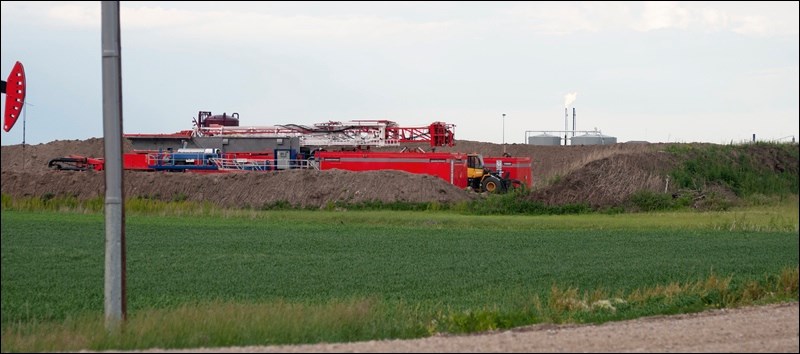About once a month I do an in-depth analysis of the drilling rig activity in Saskatchewan, and to a lesser extent, throughout Canada. And what I found this month was disturbing.
Why do I follow rig counts so closely? They are, by far, the most significant leading indicator of the oil industry. Not only do they show activity levels, but areas seeing investment, hot plays, confidence, corporate strength, and so much more. You don’t frack a well, you don’t complete a well, you don’t build a pipeline to it or a battery for it, until you drill that well first.
Having finished five years into this oil downturn and going into year six, it is still possible for things to get worse. And they are.
Broadly put, the drilling rig activity nation-wide is consistently down roughly 30 to 40 per cent throughout the busy times of the year, i.e. everything that is not spring breakup.
The busiest time of the year runs from the first week of January to mid-March, a period known to some as the 100 days of hell. Things slow down dramatically during spring breakup, especially in Saskatchewan, where drilling all but ceases. In Manitoba, it does. Then they pick up in July and remain relatively flat until Christmas.
(For all intents and purposes, Manitoba’s activity in recent years is a rounding error compared to the other provinces, so I’m going to leave it out for the rest of this analysis.)
The numbers I am using come from sister publication Rig Locator (riglocator.ca). They’re not always perfect, but generally pretty damned close.
For most jurisdictions, 2017 and 2018 were pretty close most of the year. Alberta was nearly a mirror image, but British Columbi had somewhat more deviation. Nationally, the numbers for those years showed very similar rig counts and trends. But then, at the end of 2018, we saw Alberta start to nosedive.
The big story here is Alberta. After the drop-off in December last year, it has been consistently lower through the entire course of 2019. Feb. 1, 2017 saw 251 Alberta rigs working, and 248 the same day in 2018. But in 2019, the number was only 155. In 2012, it was around 490.
It is only now, in mid-July, that one can see Alberta’s rig count is nearly flatlined, hardly creeping above its spring breakup levels. During spring breakup, the rig count floated around 50. On July 15, it was only 80. That may seem like a lot, until you realize that July 12, 2017 had 131 rigs, and July 12, 2018 had 149. And both of those numbers are a mere shadow of what they were from 2010-2014, when they were 250 to 350.
Saskatchewan’s doing a little better, but not by much. B.C. is doing even worse. Instead of picking up after breakup, the normal pattern, it has actually declined.
All this is reflected in the total size of the drilling rig fleet.
When the downturn started, in June 2014, there were roughly 800 drilling rigs in Canada. During the busiest times, around three quarters would be working. Now there are only 548 rigs on the books in Canada. The fleet has declined by about 250. Maybe some could be reactivated. But many of that missing 250 have been retired or cut up for scrap. Some have been sent south, to the U.S. where things are hopping (with the same oil price, I might add).
So what gives? What are the underlying reasons for this horrendously poor performance in drilling right now?
Some would blame the Rachel Notley NDP government in Alberta for a good portion of it. Perhaps you could, in that the decline in drilling at the end of 2018 appears to directly correlate with the imposition of production curtailment. That curtailment largely cured the huge price differentials, but it also really pushed the bigger companies away from active drilling programs. Why drill for more oil when you have to curtail the production you already have? Just sit on your hands for six to eight months, and your natural declines should take care of those curtailment numbers by themselves. Note, we’re about eight months down the road now.
But if you’re going to make that argument, you probably want to make the corresponding argument that the election of Jason Kenney is something approximating the second coming of Christ. I haven’t seen that much hype about someone being elected since Barrack Obama was first elected president.
Kenney has been going hard like no other newly-elected politician I’ve ever seen. In June, in Weyburn, I asked him if he ever slept. He replied to the effect that his staff wished he would.
But despite all his recent efforts, he has not proven to have the Midas touch when it comes to drilling activity.
So what else could it be? I suspect a large part of this sluggishness is the hangover from the Redwater Energy decision in late January, which piled onto the curtailment and heavy oil differential woes.
Simply put, the Supreme Court of Canada said in Redwater that if a company goes belly up, its environmental liability must be paid before secured creditors. I think that decision fundamentally shook up the entire investment community’s thought processes when it comes to oil and gas. No matter what they do, investors have now and forevermore been knocked down a peg when it comes to a company’s obligations when things get rough. They can’t walk away from old wells.
I could be wrong about Redwater. But I don’t think so. I think it is having more of an impact than people realize, and that’s being reflected in the poor drilling numbers today.
Did I say poor? I meant abysmal, at least in Alberta.
Brian Zinchuk is editor of Pipeline News. He can be reached at brian.zinchuk@sasktel.net.



